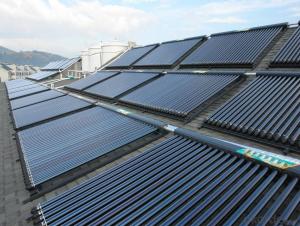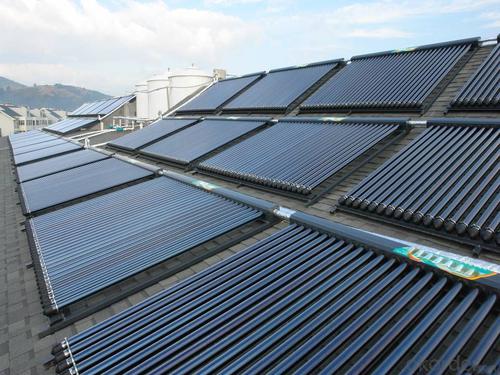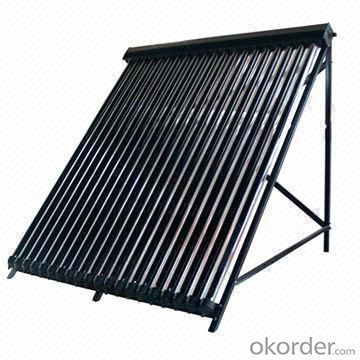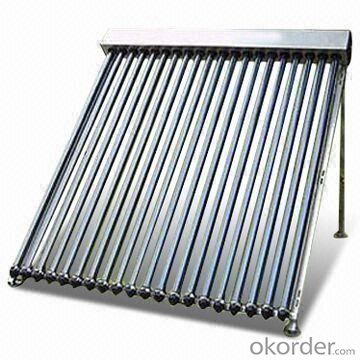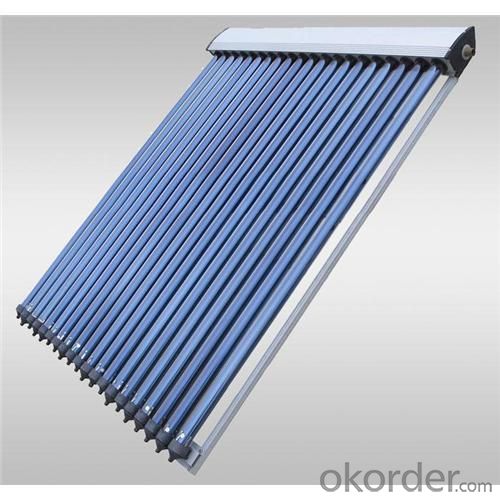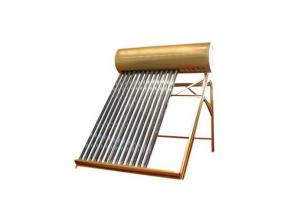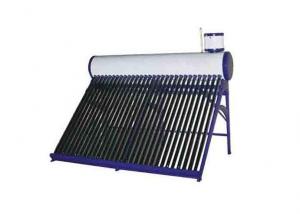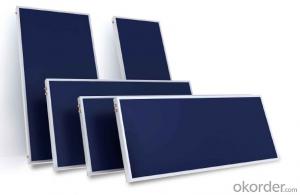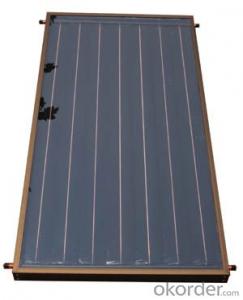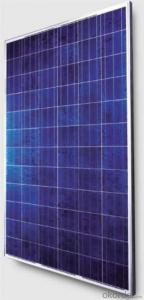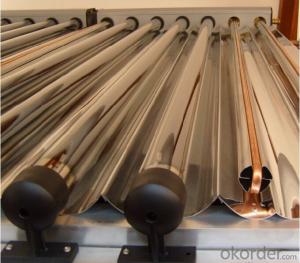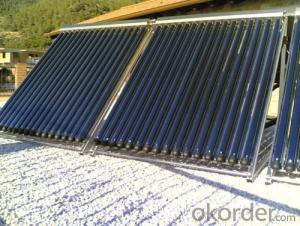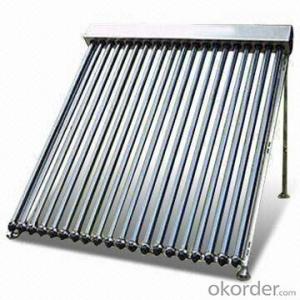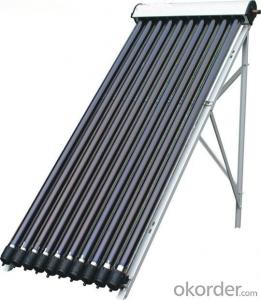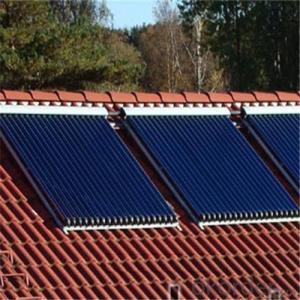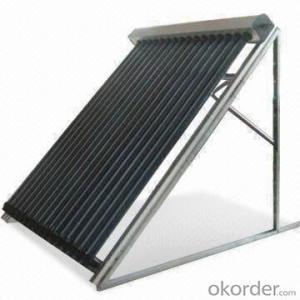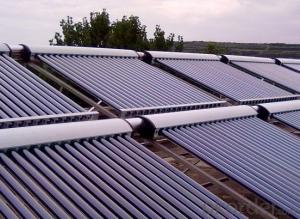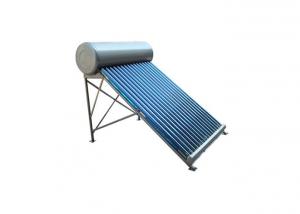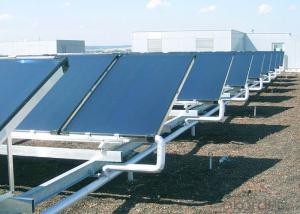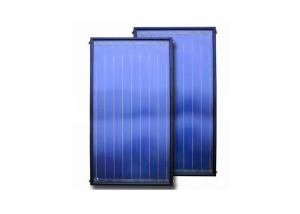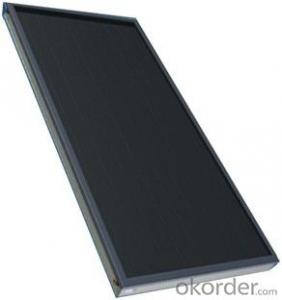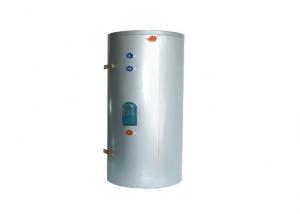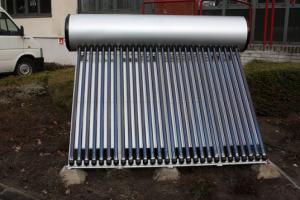Viessmann Evacuated Tube Solar Collectors - Heat Pipes for Rooftop, Made in China
- Loading Port:
- China main port
- Payment Terms:
- TT OR LC
- Min Order Qty:
- 5 set
- Supply Capability:
- 10000 set/month
OKorder Service Pledge
OKorder Financial Service
You Might Also Like
Specifications
manifold (inner) | red copper |
manifold (exterior) | aluminum alloy |
glass tube dimensions | 58mm * 1800mm |
daily efficiency | ≥55% |
heat preservation | 72 hours |
hail resistance | 25mm |
max pressure | 7 bar |
coating of vacuum tube | ALN/AIN-SS/CU |
heat pipe | anti-freezing > -35 degree |
certificate | Solar Keymark, EN12975,SRCC |
Serious Product
Models | L*W*H mm | Vacuum tube | Power output | Efficiency | Header mm | Frame | container loading 20FT/40HQ sets | Gross Weight kg |
SHC-8 | 1917*910*133 | 58*1800*8pcs | 939W | 0.668 | Φ35/1.0 | AL alloy | 185/445 | 27 |
SHC-10 | 1917*1130*133 | 58*1800*10pcs | 1189W | 159/385 | 33 | |||
SHC-12 | 1917*1350*133 | 58*1800*12pcs | 1440W | 149/358 | 40 | |||
SHC-15 | 1917*1680*133 | 58*1800*15pcs | 1815W | 120/290 | 49 | |||
SHC-18 | 1917*2010*133 | 58*1800*18pcs | 2191W | 100/242 | 59 | |||
SHC-20 | 1917*2230*133 | 58*1800*20pcs | 2442W | 87/210 | 66 | |||
SHC-22 | 1917*2450*133 | 58*1800*22pcs | 2692W | 83/202 | 72 | |||
SHC-24 | 1917*2670*133 | 58*1800*24pcs | 2943W | 77/188 | 79 |
Packaging & Delivery
Packaging Details: | Exporting Carton with big foaming protection |
Delivery Detail: | In 10-15 days |
Loading Quantity
Model | Tube | Tube Q.T.Y | Loading Q.T.Y/40HQ |
GSC15 | 58*1800mm | 15pcs | 315sets |
GSC18 | 58*1800mm | 18pcs | 265sets |
GSC20 | 58*1800mm | 20pcs | 248sets |
GSC22 | 58*1800mm | 22pcs | 225sets |
GSC25 | 58*1800mm | 25pcs | 200sets |
GSC30 | 58*1800mm | 30pcs | 168sets |
Principle of solar collector:
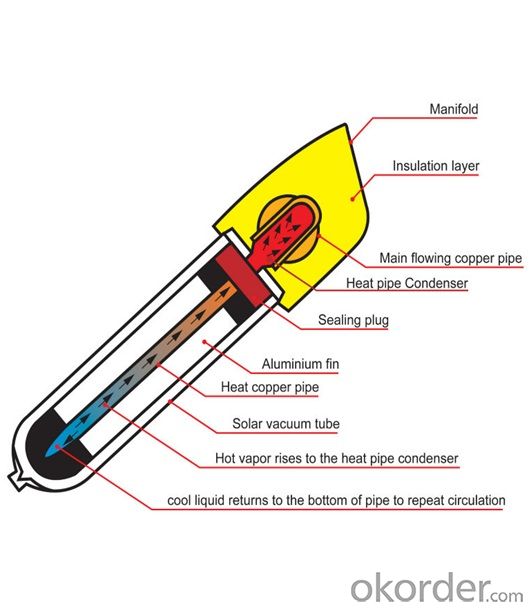
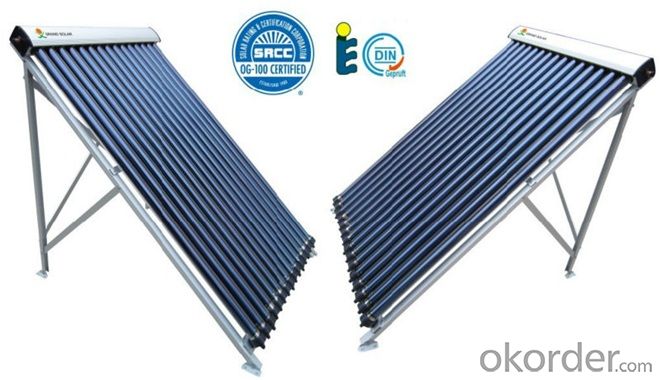
Solar collector details
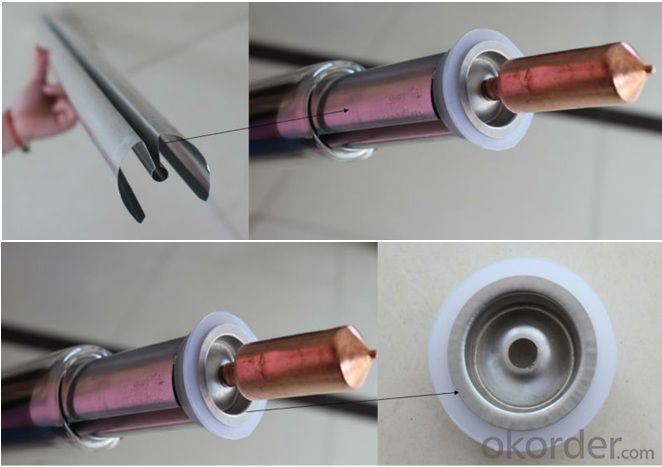
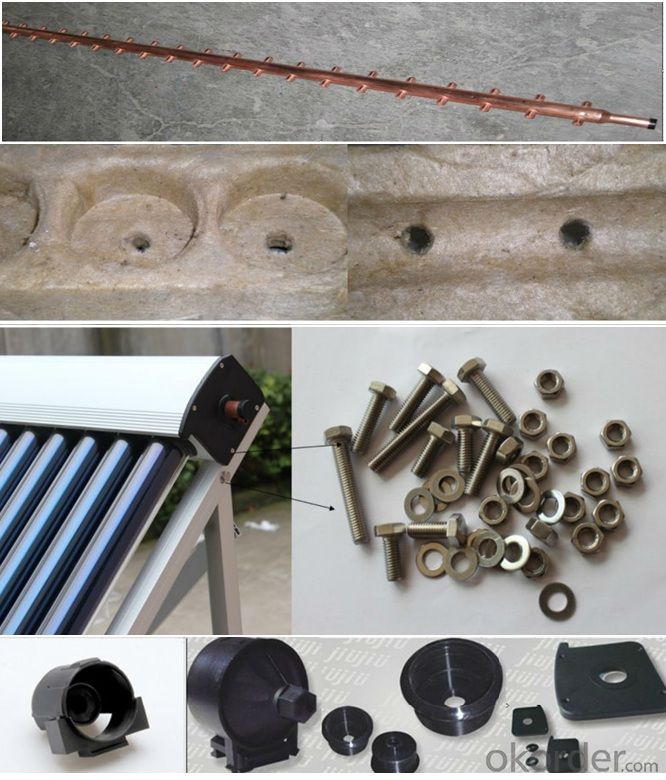
- Q: How much maintenance do solar collectors require?
- Solar collectors require minimal maintenance. They are designed to be durable and long-lasting, with few moving parts. Regular cleaning of the panels to remove dust and debris is recommended, but other than that, occasional inspections to check for any issues or malfunctions are typically sufficient. Overall, solar collectors are a low-maintenance solution for harnessing solar energy.
- Q: Can solar collectors be used for generating electricity on public transportation systems?
- Public transportation systems can indeed utilize solar collectors for electricity generation. These devices, also referred to as solar panels or photovoltaic (PV) panels, convert sunlight into electrical energy through the photovoltaic effect. They can be conveniently installed on various parts of public transportation systems, including roofs, sides, and even integrated into windows. By making use of solar energy, public transportation systems can reduce their dependence on fossil fuels and lower their carbon footprint. The generated electricity can power various components of the transportation system, such as lighting, air conditioning, and even electric vehicle charging stations. Additionally, any surplus electricity can be stored in batteries for later use during periods of limited sunlight, ensuring a continuous supply of power. The integration of solar collectors on public transportation systems offers several advantages. Firstly, it reduces operational expenses by reducing the need for external sources of electricity. This can result in substantial long-term savings, particularly for larger transportation systems. Secondly, it promotes sustainability and environmental friendliness by utilizing clean and renewable energy sources. This helps combat climate change and enhances air quality in urban areas. Furthermore, the presence of solar panels on public transportation systems can serve as a visible symbol of eco-friendly initiatives, raising awareness and encouraging individuals to adopt more sustainable practices. It can also inspire other transportation systems to follow suit and implement similar renewable energy solutions. While certain challenges need to be considered, such as initial investment costs and limited space for solar panel installation on certain vehicles, technological advancements and decreasing costs of solar panels are making this solution increasingly feasible. With careful planning and design, solar collectors can play a critical role in generating electricity for public transportation systems, contributing to a cleaner and more sustainable future.
- Q: How do solar collectors perform in extreme weather conditions?
- Solar collectors have been specifically designed to withstand and function effectively in different weather conditions, including extreme ones. In cold weather, solar collectors are equipped with insulation and anti-freezing mechanisms to prevent any damage caused by freezing temperatures. These mechanisms guarantee that the fluid circulating within the collectors remains unfrozen, which prevents any cracks or harm to the system. On the other hand, solar collectors have been constructed to handle high temperatures during extremely hot weather without compromising their performance. They are made from durable materials that can endure the heat and maintain their efficiency, even under scorching conditions. Moreover, the design incorporates proper ventilation and cooling systems to prevent overheating and optimize the overall performance of the system. During heavy rain or snowfall, solar collectors have been specifically designed to shed water and prevent any accumulation on their surface. This design feature ensures that the panels can continue to operate efficiently by minimizing any interference caused by water or ice. Additionally, solar collectors are built to be sturdy and durable, capable of withstanding strong winds, hail, or any other severe weather conditions. It is important to note that extreme weather conditions may temporarily affect the output of solar collectors, as solar radiation may be reduced or blocked. However, modern solar collectors have been designed to optimize energy absorption and conversion even in less than ideal conditions. Furthermore, solar collectors can be installed at the most optimal angle and orientation to maximize their performance throughout the year, taking into consideration the specific weather patterns of the region. All in all, solar collectors have been engineered to be resilient and function well in extreme weather conditions. They undergo rigorous testing and certifications to ensure their durability and efficiency under various environmental circumstances. With proper installation and regular maintenance, solar collectors can continue to generate clean and renewable energy even in the face of challenging weather conditions.
- Q: Can solar collectors be used for pool heating?
- Yes, solar collectors can be used for pool heating.
- Q: Can solar collectors be used for heating warehouses and storage facilities?
- Yes, solar collectors can be used for heating warehouses and storage facilities. Solar thermal systems, which use solar collectors to absorb the sun's energy and convert it into heat, can be installed to provide space heating and hot water for these types of buildings. By utilizing renewable solar energy, these systems can help reduce heating costs and carbon emissions while providing efficient and sustainable heating solutions.
- Q: Can solar collectors be installed on rooftops?
- Yes, solar collectors can be installed on rooftops.
- Q: What is the size of a typical solar collector?
- The size of a typical solar collector can vary depending on the specific application and design. However, a common size for a residential solar collector is around 2 meters by 1.2 meters, or approximately 6.5 feet by 4 feet.
- Q: Can solar collectors be used for heating industrial facilities?
- Yes, solar collectors can be used for heating industrial facilities. Solar thermal systems can effectively capture and convert sunlight into heat energy, which can be used for various heating applications in industrial settings such as space heating, water heating, and process heating. The installation of solar collectors can help reduce the reliance on fossil fuels, lower energy costs, and contribute to a more sustainable and environmentally friendly operation of industrial facilities.
- Q: Can solar collectors be used in areas with limited access to materials?
- Yes, solar collectors can be used in areas with limited access to materials. Solar collectors are designed to harness solar energy and convert it into usable forms of energy, such as electricity or heat. They can be made using readily available materials like glass, metal, and plastic. In areas with limited access to materials, simpler and more cost-effective designs can be implemented, such as using local materials like wood or recycled materials. Additionally, solar collectors can be scaled to match the energy demands of the specific area, making them suitable for a wide range of environments with various material limitations.
- Q: Can solar collectors be used in residential areas?
- Residential areas can definitely make use of solar collectors. In fact, these devices are being adopted more and more in neighborhoods across the globe. Solar collectors, also known as solar panels or photovoltaic (PV) systems, are specifically designed to convert sunlight into usable electricity. They can be mounted on rooftops, walls, or even stand alone in open spaces found within residential properties. The utilization of solar collectors in residential areas offers a multitude of advantages. Firstly, they provide a clean and renewable energy source, reducing dependence on fossil fuels and contributing to a greener and more sustainable future. Solar energy is abundant and readily accessible, making it an ideal choice for residential areas. Secondly, solar collectors have the potential to substantially reduce homeowners' electricity bills. By generating electricity on-site, residents can offset their energy consumption from the grid, leading to significant cost savings over time. In some instances, excess energy produced by solar collectors can even be sold back to the grid through net metering programs, further lowering electricity costs. Moreover, solar collectors require minimal upkeep and boast a long lifespan, typically lasting 25 to 30 years or more. This makes them a reliable and cost-effective investment for homeowners. Additionally, many governments and local authorities offer incentives and tax credits to encourage the adoption of solar power in residential areas, making the initial installation costs more affordable. Although there may be some concerns regarding aesthetics, modern solar collectors are designed to seamlessly blend with residential architecture. Numerous options are available to cater to different styles and preferences. Furthermore, advancements in technology have increased the efficiency and compactness of solar collectors, allowing for greater flexibility in installation. In conclusion, solar collectors are a practical and feasible choice for residential areas. They provide clean and renewable energy, reduce electricity bills, require minimal maintenance, and have long lifespans. With the growing emphasis on sustainability and the availability of government incentives, it is no surprise that solar collectors are gaining popularity in residential neighborhoods worldwide.
Send your message to us
Viessmann Evacuated Tube Solar Collectors - Heat Pipes for Rooftop, Made in China
- Loading Port:
- China main port
- Payment Terms:
- TT OR LC
- Min Order Qty:
- 5 set
- Supply Capability:
- 10000 set/month
OKorder Service Pledge
OKorder Financial Service
Similar products
Hot products
Hot Searches
Related keywords
